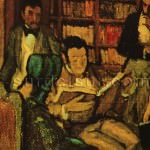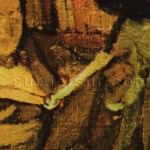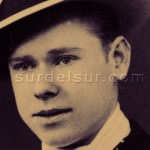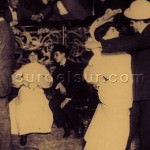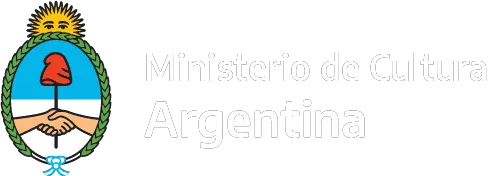Lunfardo and tango are certainly not blood brothers. Tango has black blood and lunfardo has gringo blood. I am not taking sides, as far as tango is concerned, in the controversy between Hispanists and Nigroists; I am just saying that what is Spanish in tango is of African lineage, including Andalusian tango, which had been Afro-Cuban before being Andalusian.
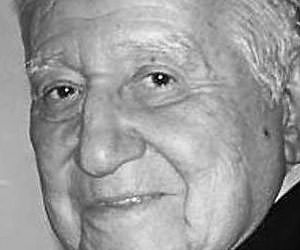
Article of the guest columnist for surdelsur.com
I am more certain about the “lunfardo scion” grafted onto the tree of the popular speech of Buenos Aires, where rural voices and turns were strong.
The Compadrito’s Tango
I think it inaccurate to speak of tango as a whole. I rather suspect that compadrito’s tango (which was cheerful, brazen, speedy for dancing and merry) is not the same tango of immigrant’s children, which was sad, sentimental, withdrawn and whose lyrics were full of grim stories of love and betrayal. I choose Villoldo to embody the former and Contursi the latter. Villoldo’s tango already drew on lunfardo, though not through a very wide range, because by that time, lunfardo itself did not cover a wide range.
The Immigrant’s Tango
If lunfardo had been the mixture of compadrito’s speech with that of immigrant, it would have turned Papiamento, Creole, mixed language. But, although the public school, by strengthening national language (Spanish), prevented a linguistic muddle more typical of a free port than of a new and glorious nation, it could not keep some voices of Italian origin (derived from Genoese, Neapolitan, Furbesque) from starting to flow through the compadrito’s lips, who started to “italianize” and merge European and rural voices, as did the protagonist of Ivette, a tango by Pascual Contursi:
¿No te acordás que conmigo / usaste el primer sombrero / y aquel cinturón de cuero / que a un esmujen le amuré? / ¿No te traje pa tu santo / un par de zarzos debute, / que una noche a un farabute / del cotorro le pianté? / Y con ellos unas botas / con la caña de gamuza / y una pollera papusa / hecha de seda crepé.
The next lines are the prose explanation of the meaning of Contursi’s verses, of course, this explanation lacks the charm and the climate of the lunfardo version:
Don’t you remember that I made you wear your first hat and a leather belt I stole? Didn’t I bring you, for your name day, a pair of beautiful ear-rings I stole from a jerk’s room? And besides, suede boots and a cool silk skirt.
Meaning of Lunfardo Words
The definitions, taken from “Nuevo Diccionario Lunfardo” (New Lunfardo Dictionary), by José Gobello, are restricted to the particular sense in the sentence and do not include all its possible meanings.
Meaning ot the Lunfardo Terms Included in the Text
Compadrito:
Young man from the suburbs who mimicked the compadres’ attitudes.
Compadre:
Gaucho absorbed by the city who kept his independent attitude in his clothing and behavior. Bragging and belligerent person.
Esmujen:
A person who worked in a second-hand shop known as cambalache.
Amuré:
First person singular of the verb amurar. To swindle.
Zarzos:
Ear-ring
Debute:
Excellent, supreme, best-quality.
Farabute:
Scoundrel, rouge, braggart.
Cotorro:
Lodging, room, especially of a single male.
Pianté:
From espiantar
Espiantar:
To rob. To dispossess, to deprive someone of something. To remove surreptitiously.
Papusa:
From papa
Papa:
Beautiful thing of top-quality or use.
Crepé:
In the expression “seda crepé”, silk fabrik in which the warp is more twisted than the filling, resembling crepe.
Percanta:
Woman, as seen from the amatory standpoint.
Amuraste:
Second person singular of the verb amurar. To abandon.
Tango -not couple prefiguring it, but tango taken from the dancers’ feet to the lips- begins having lyrics when Contursi writes it.
Lunfardo and Tango together in the first lyrics
The first lyrics, in terms of relevance if not of chronology, is that the tango named Lita, which was renamed as Mi noche triste (My Sad Night): First Time a Tango was Sung. Those memorable octosyllabic verses start with a lunfardo term: “percanta que me amuraste” (Woman, you who left me).
After Contursi’s pattern, many other lyricists “lunfardized”, mainly Celedonio Esteban Flores, who did it with great talent. Homero Manzi -in whose poetic genealogy are González Castillo and Borges-, did without that wild vocabulary and so did Discépolo in his last years. Homero Expósito only “lunfardized” once in a while. And modern tango, whose prince is Horacio Ferrer, wisely turns to it as a literary touch rather than a language.
To learn more about tango, consult the report History of Tango Argentino and also Carlos Gardel: The voice of Tango. This last report available in spanish only.
Bibliografía
- Academia Porteña del Lunfardo. Miembro fundador José Gobello. Biografía


